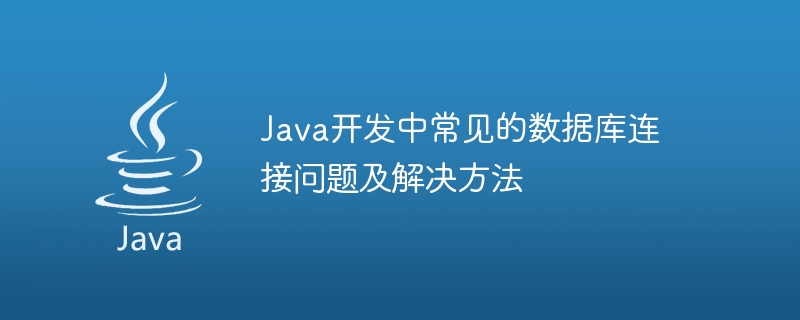Home >Java >javaTutorial >Common database connection problems and solutions in Java development
Common database connection problems and solutions in Java development
- 王林Original
- 2023-10-09 09:39:22594browse

Common database connection problems and solutions in Java development
In Java development, connecting to the database is a very common operation. However, we often encounter some problems during the process of connecting to the database. This article will introduce some common database connection problems and provide corresponding solutions and code examples.
- Insufficient database connection pool
When the concurrent access to the system increases, the database connection pool may be insufficient, resulting in the connection request being rejected or performance degradation. To avoid this, we can increase the size of the database connection pool or use a connection pooling framework to manage connections.
The following is a sample code using the c3p0 connection pool framework:
import com.mchange.v2.c3p0.ComboPooledDataSource;
import java.sql.Connection;
import java.sql.SQLException;
public class DatabaseUtil {
private static ComboPooledDataSource dataSource;
static {
dataSource = new ComboPooledDataSource();
// 配置数据库连接信息
dataSource.setDriverClass("com.mysql.jdbc.Driver");
dataSource.setJdbcUrl("jdbc:mysql://localhost:3306/mydb");
dataSource.setUser("username");
dataSource.setPassword("password");
// 设置最大连接数
dataSource.setMaxPoolSize(50);
}
public static Connection getConnection() throws SQLException {
return dataSource.getConnection();
}
}- Connection leak
If we do not close the database connection correctly, it will cause Connection leak. Connection leaks will occupy resources in the database connection pool, resulting in insufficient connections in the connection pool.
In order to avoid connection leaks, we can use the try-with-resources statement block in the program to ensure that the connection can be closed correctly.
The following is a sample code using try-with-resources:
try (Connection conn = DatabaseUtil.getConnection();
Statement stmt = conn.createStatement();
ResultSet rs = stmt.executeQuery("SELECT * FROM users")) {
while (rs.next()) {
// 处理结果集
}
} catch (SQLException e) {
e.printStackTrace();
}- Database connection timeout
In high concurrency scenarios , the database connection may be occupied for a long time, causing other connections to time out. To avoid this, we can set a timeout when getting a connection.
The following is a sample code that uses the c3p0 connection pooling framework to set the connection timeout:
dataSource.setCheckoutTimeout(3000); // 设置连接超时时间为3秒
- The connection was unexpectedly closed
If the database connection is closed unexpectedly, such as the database service crashes or the network is interrupted, we can use the heartbeat detection mechanism of the connection pool to detect and re-establish the connection.
The following is a sample code for setting up heartbeat detection using the c3p0 connection pool framework:
dataSource.setPreferredTestQuery("SELECT 1"); // 设置心跳检测SQL语句
dataSource.setIdleConnectionTestPeriod(600); // 设置心跳检测间隔时间为10分钟Summary:
In Java development, encounter database connections The problem is very common. By using a connection pool to manage connections, closing connections correctly, setting connection timeouts, and using a heartbeat detection mechanism, we can avoid most database connection problems. I hope the solutions and code examples in this article can help developers solve actual database connection problems.
The above is the detailed content of Common database connection problems and solutions in Java development. For more information, please follow other related articles on the PHP Chinese website!

